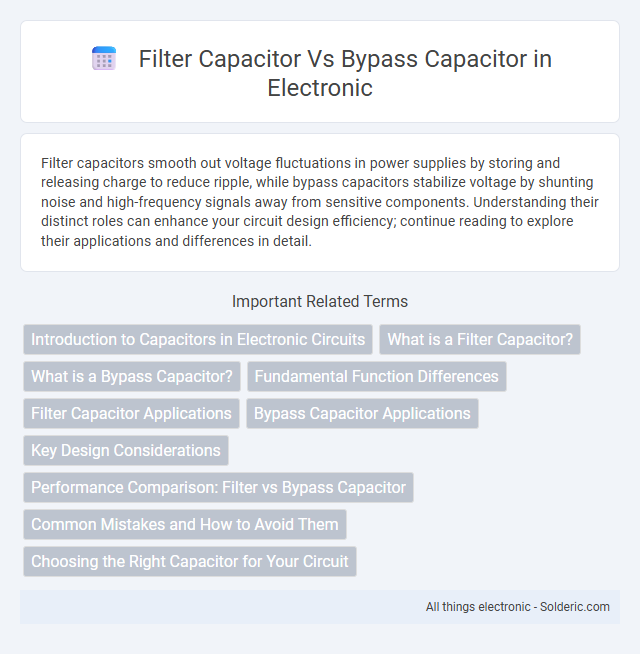Filter capacitors smooth out voltage fluctuations in power supplies by storing and releasing charge to reduce ripple, while bypass capacitors stabilize voltage by shunting noise and high-frequency signals away from sensitive components. Understanding their distinct roles can enhance your circuit design efficiency; continue reading to explore their applications and differences in detail.
Comparison Table
| Feature | Filter Capacitor | Bypass Capacitor |
|---|---|---|
| Purpose | Reduces ripple voltage in power supplies | Eliminates high-frequency noise and stabilizes voltage |
| Placement | Connected after rectifier in power supply circuits | Placed parallel to active devices like ICs and transistors |
| Capacitance Range | High (microfarads to millifarads) | Low (picofarads to microfarads) |
| Frequency Response | Effective at low frequencies | Effective at high frequencies |
| Function | Smooths DC output by filtering AC components | Provides a low impedance path to ground for noise signals |
| Common Types | Electrolytic capacitors | Ceramic capacitors |
Introduction to Capacitors in Electronic Circuits
Capacitors in electronic circuits serve various functions such as filtering and bypassing to maintain signal integrity and stability. A filter capacitor smooths out voltage fluctuations by storing and releasing energy, reducing ripple in power supplies. Bypass capacitors, connected in parallel with ICs or other components, provide a low impedance path to ground for high-frequency noise, thereby enhancing your circuit's performance and reducing electromagnetic interference.
What is a Filter Capacitor?
A filter capacitor smooths out fluctuations in voltage by reducing the ripple in power supplies, ensuring a steady DC output from an AC source. It works by storing energy and releasing it during voltage dips, which stabilizes the electric current flowing to your circuit. In contrast to bypass capacitors, filter capacitors primarily focus on energy storage and voltage regulation within power conversion systems.
What is a Bypass Capacitor?
A bypass capacitor is a small-value capacitor connected in parallel with a power supply line to ground, designed to filter out high-frequency noise and stabilize voltage by providing a low-impedance path for AC signals. Unlike filter capacitors that smooth DC voltage in power supplies, bypass capacitors prevent voltage fluctuations in integrated circuits by shunting transient currents. These capacitors are critical in digital and analog circuits to maintain signal integrity and reduce electromagnetic interference.
Fundamental Function Differences
Filter capacitors primarily smooth out voltage fluctuations by storing and releasing energy to reduce ripple in power supplies, ensuring a stable DC output. Bypass capacitors, placed close to integrated circuits, minimize high-frequency noise and voltage spikes by providing a low impedance path to ground. Your electronic circuit performance depends on correctly choosing between these capacitors to address power stability versus noise reduction.
Filter Capacitor Applications
Filter capacitors are primarily used in power supply circuits to smooth out the rectified output voltage by reducing ripple and providing a steady DC voltage. Common applications include voltage regulators, audio equipment, and DC power supplies where maintaining a stable voltage is critical. They are typically large electrolytic capacitors designed to handle high ripple currents and energy storage.
Bypass Capacitor Applications
Bypass capacitors are primarily used in electronic circuits to stabilize voltage supply by shunting high-frequency noise to ground, ensuring smooth operation of integrated circuits and amplifiers. They are placed close to power pins of ICs to minimize voltage fluctuations and prevent signal interference caused by electromagnetic noise. Your circuit's performance improves significantly with proper bypass capacitor application, enhancing noise reduction and maintaining signal integrity.
Key Design Considerations
Filter capacitors require careful selection of capacitance and voltage rating to effectively smooth out voltage ripples in power supplies, ensuring steady DC output. Bypass capacitors demand placement close to active devices with low equivalent series resistance (ESR) and appropriate capacitance to suppress high-frequency noise and stabilize voltage rails. Your circuit's frequency response and transient current demands significantly influence the choice and placement of these capacitors for optimal performance.
Performance Comparison: Filter vs Bypass Capacitor
Filter capacitors primarily smooth out voltage fluctuations by filtering ripple in power supplies, enhancing overall circuit stability. Bypass capacitors improve high-frequency performance by providing a low-impedance path to ground, reducing noise and voltage spikes near active devices. The key performance difference lies in the filter capacitor's role in power regulation versus the bypass capacitor's focus on noise suppression and signal integrity.
Common Mistakes and How to Avoid Them
Common mistakes in using filter capacitors include selecting incorrect capacitance values, leading to insufficient ripple reduction in power supplies. Bypass capacitor errors often stem from using capacitors with high equivalent series resistance (ESR), reducing their effectiveness in high-frequency noise suppression. To avoid these issues, choose filter capacitors with appropriate capacitance and voltage ratings for smoothing DC output, and use low-ESR bypass capacitors placed close to IC power pins for optimal high-frequency filtering.
Choosing the Right Capacitor for Your Circuit
Filter capacitors are designed to smooth out voltage fluctuations by storing and releasing energy, making them ideal for power supply circuits. Bypass capacitors, on the other hand, are crucial for reducing high-frequency noise by providing a low-impedance path to ground near active devices. Choosing the right capacitor involves considering factors such as capacitance value, tolerance, voltage rating, and the specific role in minimizing noise or stabilizing voltage within your circuit.
filter capacitor vs bypass capacitor Infographic

 solderic.com
solderic.com